MTD TALLER TRACTORES CORTACESPED LIBRO 2 SERVICE MANUAL
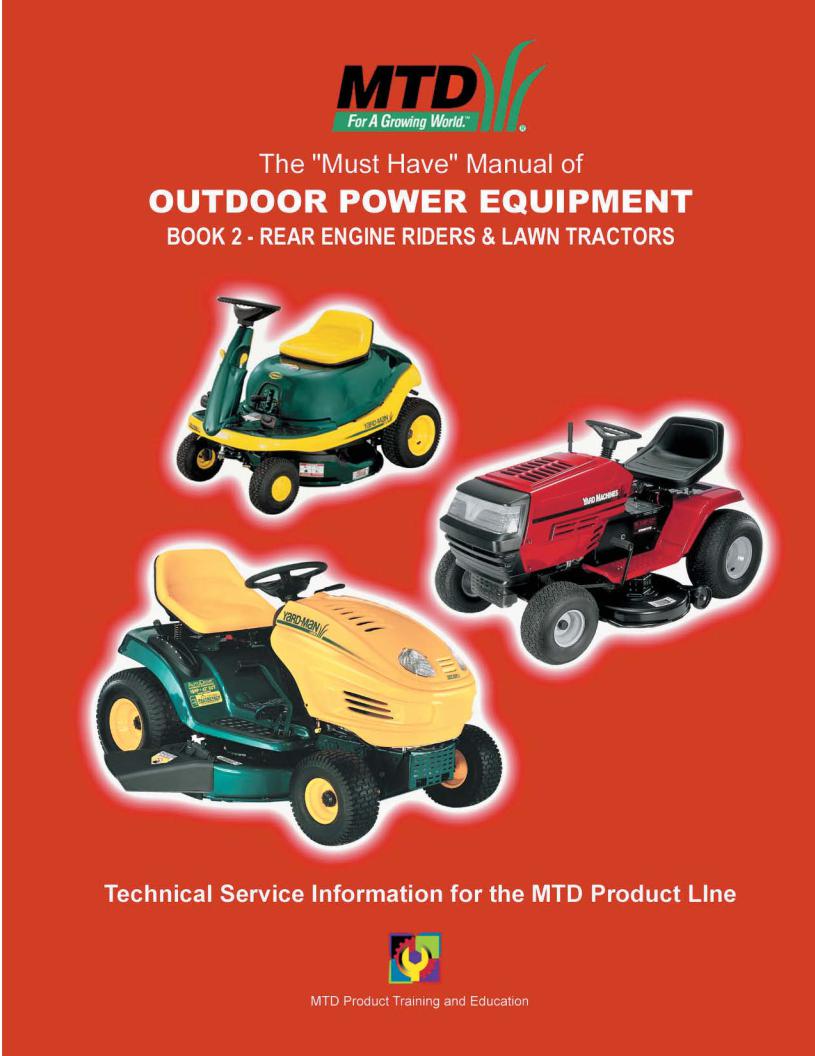
MANUALEQUIPOSPESADOS.COM
MTD SERVICE LLC Product Training and Education Department

MANUALEQUIPOSPESADOS.COM
TABLE OF CONTENTS
WORK SAFETY . . . . . . . . . . . . . . . . . . . . . . . . . . . . . . . . . . . . . . . . . . . . . . . . . . . . . . . . . . . . . . . . . . Section 1
GENERAL INFORMATION . . . . . . . . . . . . . . . . . . . . . . . . . . . . . . . . . . . . . . . . . . . . . . . . . . . . . . . . . . Section 2
Safety Precautions . . . . . . . . . . . . . . . . . . . . . . . . . . . . . . . . . . . . . . . . . . . . . . . . . . . . . . . . . . . . . . . . . . . 2-1
Batteries And Charging Systems. . . . . . . . . . . . . . . . . . . . . . . . . . . . . . . . . . . . . . . . . . . . . . . . . . . . . . . . . 2-2
ELECTRICAL . . . . . . . . . . . . . . . . . . . . . . . . . . . . . . . . . . . . . . . . . . . . . . . . . . . . . . . . . . . . . . . . . . . . Section 3
Safety Interlock Systems. . . . . . . . . . . . . . . . . . . . . . . . . . . . . . . . . . . . . . . . . . . . . . . . . . . . . . . . . . . . . . . 3-1 Safety Interlock Systems - Changes for 1991 . . . . . . . . . . . . . . . . . . . . . . . . . . . . . . . . . . . . . . . . . . . . . . . 3-1 Electric Start System . . . . . . . . . . . . . . . . . . . . . . . . . . . . . . . . . . . . . . . . . . . . . . . . . . . . . . . . . . . . . . . . . . 3-3 Recoil Start System. . . . . . . . . . . . . . . . . . . . . . . . . . . . . . . . . . . . . . . . . . . . . . . . . . . . . . . . . . . . . . . . . . . 3-6 Safety Interlock Systems Wiring Diagrams . . . . . . . . . . . . . . . . . . . . . . . . . . . . . . . . . . . . . . . . . . . . . . . . 3-10
Troubleshooting Safety Interlock Systems . . . . . . . . . . . . . . . . . . . . . . . . . . . . . . . . . . . . . . . . . . . . . . . . 3-23 Evaluating Electric Clutches . . . . . . . . . . . . . . . . . . . . . . . . . . . . . . . . . . . . . . . . . . . . . . . . . . . . . . . . . . . 3-56
BELTS AND DRIVE SYSTEM . . . . . . . . . . . . . . . . . . . . . . . . . . . . . . . . . . . . . . . . . . . . . . . . . . . . . . . . Section 4
General . . . . . . . . . . . . . . . . . . . . . . . . . . . . . . . . . . . . . . . . . . . . . . . . . . . . . . . . . . . . . . . . . . . . . . . . . . . 4-1
Proper Storage of Belts . . . . . . . . . . . . . . . . . . . . . . . . . . . . . . . . . . . . . . . . . . . . . . . . . . . . . . . . . . . . . . . 4-3 Causes of V-Belt Problems . . . . . . . . . . . . . . . . . . . . . . . . . . . . . . . . . . . . . . . . . . . . . . . . . . . . . . . . . . . . . 4-3 V-Belt Problems with Rotary Tillers, Self-Propelled Mowers and Riding Mowers . . . . . . . . . . . . . . . . . . . . 4-4 Belt Wear Due to Normal Life . . . . . . . . . . . . . . . . . . . . . . . . . . . . . . . . . . . . . . . . . . . . . . . . . . . . . . . . . . . 4-5 Pulley Alignment . . . . . . . . . . . . . . . . . . . . . . . . . . . . . . . . . . . . . . . . . . . . . . . . . . . . . . . . . . . . . . . . . . . . . 4-6 Idlers . . . . . . . . . . . . . . . . . . . . . . . . . . . . . . . . . . . . . . . . . . . . . . . . . . . . . . . . . . . . . . . . . . . . . . . . . . . . . . 4-6 Maintenance Of Variable Speed Pulleys . . . . . . . . . . . . . . . . . . . . . . . . . . . . . . . . . . . . . . . . . . . . . . . . . . . 4-9 Four Wheel Steering . . . . . . . . . . . . . . . . . . . . . . . . . . . . . . . . . . . . . . . . . . . . . . . . . . . . . . . . . . . . . . . . . 4-10 Disassembly Of Four Wheel Steering . . . . . . . . . . . . . . . . . . . . . . . . . . . . . . . . . . . . . . . . . . . . . . . . . . . . 4-13 Brake Adjustment for 600 and 700 Series. . . . . . . . . . . . . . . . . . . . . . . . . . . . . . . . . . . . . . . . . . . . . . . . . 4-15
HYDROSTATIC . . . . . . . . . . . . . . . . . . . . . . . . . . . . . . . . . . . . . . . . . . . . . . . . . . . . . . . . . . . . . . . . . . . Section 5
TRANSAXLES . . . . . . . . . . . . . . . . . . . . . . . . . . . . . . . . . . . . . . . . . . . . . . . . . . . . . . . . . . . . . . . . . . . Section 6
General . . . . . . . . . . . . . . . . . . . . . . . . . . . . . . . . . . . . . . . . . . . . . . . . . . . . . . . . . . . . . . . . . . . . . . . . . . . . 6-1
Transaxle Changes For 1990, 1991, 1992 and 1997 Models . . . . . . . . . . . . . . . . . . . . . . . . . . . . . . . . . . . 6-3
Disassembly/Assembly of Transaxle. . . . . . . . . . . . . . . . . . . . . . . . . . . . . . . . . . . . . . . . . . . . . . . . . . . . . . 6-5
Hydrostatic Transaxle . . . . . . . . . . . . . . . . . . . . . . . . . . . . . . . . . . . . . . . . . . . . . . . . . . . . . . . . . . . . . . . . 6-13
Integrated Hydrostatic Transaxle. . . . . . . . . . . . . . . . . . . . . . . . . . . . . . . . . . . . . . . . . . . . . . . . . . . . . . . . 6-17
LAWN TRACTORS . . . . . . . . . . . . . . . . . . . . . . . . . . . . . . . . . . . . . . . . . . . . . . . . . . . . . . . . . . . . . . . . Section 7
300 and 400 Series . . . . . . . . . . . . . . . . . . . . . . . . . . . . . . . . . . . . . . . . . . . . . . . . . . . . . . . . . . . . . . . . . . . 7-1
Rear Engine Riding Mowers 500 Series . . . . . . . . . . . . . . . . . . . . . . . . . . . . . . . . . . . . . . . . . . . . . . . . . . . 7-6
Transmatic LT 600A. . . . . . . . . . . . . . . . . . . . . . . . . . . . . . . . . . . . . . . . . . . . . . . . . . . . . . . . . . . . . . . . . . . 7-9
Hydrostatic Drive 700 Series. . . . . . . . . . . . . . . . . . . . . . . . . . . . . . . . . . . . . . . . . . . . . . . . . . . . . . . . . . . 7-35
YARD BUG . . . . . . . . . . . . . . . . . . . . . . . . . . . . . . . . . . . . . . . . . . . . . . . . . . . . . . . . . . . . . . . . . . . . . . Section 8
Deck Leveling . . . . . . . . . . . . . . . . . . . . . . . . . . . . . . . . . . . . . . . . . . . . . . . . . . . . . . . . . . . . . . . . . . . . . . . 8-1
Brake Adjustment . . . . . . . . . . . . . . . . . . . . . . . . . . . . . . . . . . . . . . . . . . . . . . . . . . . . . . . . . . . . . . . . . . . . 8-3
Blade Brake/PTO Adjustment . . . . . . . . . . . . . . . . . . . . . . . . . . . . . . . . . . . . . . . . . . . . . . . . . . . . . . . . . . . 8-5
Speed Control Pedal Adjustment. . . . . . . . . . . . . . . . . . . . . . . . . . . . . . . . . . . . . . . . . . . . . . . . . . . . . . . . . 8-6
Steering Adjustment . . . . . . . . . . . . . . . . . . . . . . . . . . . . . . . . . . . . . . . . . . . . . . . . . . . . . . . . . . . . . . . . . . 8-9
Removal and Installation of Deck Belt. . . . . . . . . . . . . . . . . . . . . . . . . . . . . . . . . . . . . . . . . . . . . . . . . . . . 8-11
Removal and Installation of Mowing Deck Assembly . . . . . . . . . . . . . . . . . . . . . . . . . . . . . . . . . . . . . . . . 8-12
Removal and Replacement of the Drive Belts. . . . . . . . . . . . . . . . . . . . . . . . . . . . . . . . . . . . . . . . . . . . . . 8-14
Transmission Removal and Installation. . . . . . . . . . . . . . . . . . . . . . . . . . . . . . . . . . . . . . . . . . . . . . . . . . . 8-16
Transmission Disassembly . . . . . . . . . . . . . . . . . . . . . . . . . . . . . . . . . . . . . . . . . . . . . . . . . . . . . . . . . . . . 8-18
Transmission Reassembly. . . . . . . . . . . . . . . . . . . . . . . . . . . . . . . . . . . . . . . . . . . . . . . . . . . . . . . . . . . . . 8-20
Electrical . . . . . . . . . . . . . . . . . . . . . . . . . . . . . . . . . . . . . . . . . . . . . . . . . . . . . . . . . . . . . . . . . . . . . . . . . . 8-23
1
2
3
4
5
6
7
8

MANUALEQUIPOSPESADOS.COM
AUTO DRIVE. . . . . . . . . . . . . . . . . . . . . . . . . . . . . . . . . . . . . . . . . . . . . . . . . . . . . . . . . . . . . . . . . . . . . Section 9
Leveling the Cutting Deck . . . . . . . . . . . . . . . . . . . . . . . . . . . . . . . . . . . . . . . . . . . . . . . . . . . . . . . . . . . . . 9-1
Deck Belt Removal and Installation . . . . . . . . . . . . . . . . . . . . . . . . . . . . . . . . . . . . . . . . . . . . . . . . . . . . . . 9-3
Cutting Deck Removal. . . . . . . . . . . . . . . . . . . . . . . . . . . . . . . . . . . . . . . . . . . . . . . . . . . . . . . . . . . . . . . . . 9-4
Brake Adjustments. . . . . . . . . . . . . . . . . . . . . . . . . . . . . . . . . . . . . . . . . . . . . . . . . . . . . . . . . . . . . . . . . . . . 9-5
Autodrive Pedal Adjustment. . . . . . . . . . . . . . . . . . . . . . . . . . . . . . . . . . . . . . . . . . . . . . . . . . . . . . . . . . . . 9-5
Drive Belt Removal and Reinstallation . . . . . . . . . . . . . . . . . . . . . . . . . . . . . . . . . . . . . . . . . . . . . . . . . . . . 9-6
Transmission Removal and Installation. . . . . . . . . . . . . . . . . . . . . . . . . . . . . . . . . . . . . . . . . . . . . . . . . . . . 9-9
Transmission Disassembly and Reassembly . . . . . . . . . . . . . . . . . . . . . . . . . . . . . . . . . . . . . . . . . . . . . . 9-11
Deck Belt Removal . . . . . . . . . . . . . . . . . . . . . . . . . . . . . . . . . . . . . . . . . . . . . . . . . . . . . . . . . . . . . . . . . . 9-14
Hydrostatic Transmission Removal . . . . . . . . . . . . . . . . . . . . . . . . . . . . . . . . . . . . . . . . . . . . . . . . . . . . . . 9-16
Steering Adjustments. . . . . . . . . . . . . . . . . . . . . . . . . . . . . . . . . . . . . . . . . . . . . . . . . . . . . . . . . . . . . . . . . 9-20
Electrical . . . . . . . . . . . . . . . . . . . . . . . . . . . . . . . . . . . . . . . . . . . . . . . . . . . . . . . . . . . . . . . . . . . . . . . . . . 9-21
Autodrive/Autocruise . . . . . . . . . . . . . . . . . . . . . . . . . . . . . . . . . . . . . . . . . . . . . . . . . . . . . . . . . . . . . . . . . 9-30
MTD Z SERIES . . . . . . . . . . . . . . . . . . . . . . . . . . . . . . . . . . . . . . . . . . . . . . . . . . . . . . . . . . . . . . . . . . Section 10
Transmission . . . . . . . . . . . . . . . . . . . . . . . . . . . . . . . . . . . . . . . . . . . . . . . . . . . . . . . . . . . . . . . . . . . . . . . 10-1
Neutral/Steering Adjustment . . . . . . . . . . . . . . . . . . . . . . . . . . . . . . . . . . . . . . . . . . . . . . . . . . . . . . . . . . . 10-1
Removal of ZTT Transmission . . . . . . . . . . . . . . . . . . . . . . . . . . . . . . . . . . . . . . . . . . . . . . . . . . . . . . . . . 10-8
Transmission Disassembly . . . . . . . . . . . . . . . . . . . . . . . . . . . . . . . . . . . . . . . . . . . . . . . . . . . . . . . . . . . 10-13
ZERO TURN TRACTORS . . . . . . . . . . . . . . . . . . . . . . . . . . . . . . . . . . . . . . . . . . . . . . . . . . . . . . . . . . .Section 11
624 Zero Turn Tractor - The Revolution . . . . . . . . . . . . . . . . . . . . . . . . . . . . . . . . . . . . . . . . . . . . . . . . . . 11-1 46" Cutting Deck . . . . . . . . . . . . . . . . . . . . . . . . . . . . . . . . . . . . . . . . . . . . . . . . . . . . . . . . . . . . . . . . . . . . 11-2 Cutting Deck Removal . . . . . . . . . . . . . . . . . . . . . . . . . . . . . . . . . . . . . . . . . . . . . . . . . . . . . . . . . . . . . . . 11-2 Lower Deck Belt Removal . . . . . . . . . . . . . . . . . . . . . . . . . . . . . . . . . . . . . . . . . . . . . . . . . . . . . . . . . . . . . 11-3 Servicing the IZT Drive Belt. . . . . . . . . . . . . . . . . . . . . . . . . . . . . . . . . . . . . . . . . . . . . . . . . . . . . . . . . . . . 11-3 Servicing the IZT . . . . . . . . . . . . . . . . . . . . . . . . . . . . . . . . . . . . . . . . . . . . . . . . . . . . . . . . . . . . . . . . . . . . 11-7 Adjustments to the IZT . . . . . . . . . . . . . . . . . . . . . . . . . . . . . . . . . . . . . . . . . . . . . . . . . . . . . . . . . . . . . . . 11-9 Parking Brake . . . . . . . . . . . . . . . . . . . . . . . . . . . . . . . . . . . . . . . . . . . . . . . . . . . . . . . . . . . . . . . . . . . . . 11-10 Under Dash Service Points1 . . . . . . . . . . . . . . . . . . . . . . . . . . . . . . . . . . . . . . . . . . . . . . . . . . . . . . . . . . 11-11 Dash Panel Removal. . . . . . . . . . . . . . . . . . . . . . . . . . . . . . . . . . . . . . . . . . . . . . . . . . . . . . . . . . . . . . . . 11-12 Front Axle . . . . . . . . . . . . . . . . . . . . . . . . . . . . . . . . . . . . . . . . . . . . . . . . . . . . . . . . . . . . . . . . . . . . . . . . 11-16
ATTACHMENTS . . . . . . . . . . . . . . . . . . . . . . . . . . . . . . . . . . . . . . . . . . . . . . . . . . . . . . . . . . . . . . . . . Section 12
Cutting Decks . . . . . . . . . . . . . . . . . . . . . . . . . . . . . . . . . . . . . . . . . . . . . . . . . . . . . . . . . . . . . . . . . . . . . . 12-3
Improvements . . . . . . . . . . . . . . . . . . . . . . . . . . . . . . . . . . . . . . . . . . . . . . . . . . . . . . . . . . . . . . . . . . . . . 12-22
Grass Collectors.. . . . . . . . . . . . . . . . . . . . . . . . . . . . . . . . . . . . . . . . . . . . . . . . . . . . . . . . . . . . . . . . . . . 12-37
Front Bumper. . . . . . . . . . . . . . . . . . . . . . . . . . . . . . . . . . . . . . . . . . . . . . . . . . . . . . . . . . . . . . . . . . . . . . 12-39
Trapac . . . . . . . . . . . . . . . . . . . . . . . . . . . . . . . . . . . . . . . . . . . . . . . . . . . . . . . . . . . . . . . . . . . . . . . . . . . 12-39
42" Dozer Blade . . . . . . . . . . . . . . . . . . . . . . . . . . . . . . . . . . . . . . . . . . . . . . . . . . . . . . . . . . . . . . . . . . . 12-40
GLOSSARY
9
10
11
12
Glossar
MANUALEQUIPOSPESADOS.COM
WORK SAFELY—FOLLOW THESE RULES |
1 |
|
|
This symbol is used to call your attention to instructions concerning your personal safety. Be sure to observe and follow these instructions.
1.To prevent accidental starting, always pull the high tension wire(s) off the spark plug(s) before servicing and/or adjusting the machine.
2.To prevent injury, do not allow children or bystanders around the machine while it is being adjusted and/or serviced.
3.Do not wear rings, wrist watches or loose fitting clothing when working on machinery; they could catch on moving parts causing serious injury. Wear sturdy, rough-soled work shoes. Never adjust and/or service a machine in bare feet, sandals or sneakers.
4.Always wear safety glasses when using a hammer, chisel or other tools that may cause chips to fly.
5.Be sure to reinstall safety devices, guards or shields after adjusting and/or servicing the machine.
6.When operating a power washer to clean a machine before servicing, be careful at all times to avoid injury. Maintain proper footing and balance at all times. Never direct the spray at people or animals, as high pressure spray can cause serious injury.
7.If a portable heater is used to heat the service area, the following precautions must be observed
a.Do not use portable heaters in presence of volatile materials such as gasoline or paint, as fire or explosion may result.
b.To avoid being burned, do not touch the heater during operation.
c.Portable heaters consume oxygen and combustion fumes can be hazardous. Heater should be used only in a well-venti- lated area. Keep a window or door partially open to provide ventilation.
d.Keep the heater at least four feet from combustible materials.
e.Never use gasoline as fuel.
8.Handle gasoline with care—it is highly flammable.
a.Use approved gasoline container.
b.Never remove the fuel tank cap or fill the fuel tank when the engine is running, is hot or indoors.Also, do not smoke when working around flammable fuel.
c.Avoid fires—be sure container or funnel does not touch the battery. Do not overfill the fuel tank. Wipe up spilled gasoline.
d.Replace fuel tank cap securely.
9.Never use trouble lights or electric powered tools that have cut and/or damaged cords or plugs. Be sure all electric tools are properly grounded.
10.Never run an engine in a confined area such as a garage or storage building any longer than is necessary for immediate moving of the machine out of or into the area. EXHAUST
GASES ARE TOXIC. OPENING DOORS AND WINDOWS MAY NOT PROVIDE ADEQUATE VENTILATION.
11.After servicing, be sure all tools, parts or servicing equipment are removed from the machine.
12.Electrical storage batteries give off highly inflammable hydrogen gas when charging and continue to do so for some time after receiving a steady charge. Do not under any circumstances allow an electric spark or an open flame near the battery. Always disconnect a battery cable before working on the electrical system.
1-1
MANUALEQUIPOSPESADOS.COM
13.Hydraulic fluid escaping under pressure can have enough force to penetrate the skin. Hydraulic fluid may also infect a minor cut or opening in the skin. If injured by escaping fluid, see a doctor at once. Serious infection or reaction can result if medical treatment is not given immediately. Do not attempt to repair or tighten hoses that are under pressure, when the boom is raised or with the tractor engine running. Cycle all hydraulic control valves to relieve all pressure before disconnecting the lines or performing other work on the hydraulic system. Make sure all connections are tight and hoses and lines are in good condition before applying pressure to the system. To locate a leak under pressure, use a small piece of cardboard or wood. Never use hands.
14When using an acetylene torch, always wear welding goggles and gloves. Keep a charged fire extinguisher within reach. Do not weld or heat areas near fuel tanks or fuel lines and utilize proper shielding around hydraulic lines.
15.Always use safety stands in conjunction with hydraulic jacks or hoists. Do not rely on the jack or hoist to carry the load; it could fail. Always use a safety bar to block hydraulic cylinders.
16.When splitting tractors or disassembling machines, be sure to use safety stands and adequate supports to prevent tipping or rollover.
17.Use a safety catch on all hoist hooks. Do not take a chance, the load could slip off the hook.
18.Use pullers to remove bearings, bushings, gears, cylinder sleeves, etc. when applicable. Use hammers, punches and chisels only when absolutely necessary. Then, be sure to wear safety glasses.
19.Be careful when using compressed air to dry parts. Use approved air blow guns, do not exceed 30 psi, wear safety glasses or goggles and use proper shielding to protect everyone in the work area.
20.Petroleum based solvents, often used for cleaning parts, are flammable. Use care to avoid fire or explosion when using these solvents.
IMPORTANT: The above is only a partial list of safe work rules. In addition, always refer to the Operator’s Manual for the specific machine for additional safe work rules regarding the machine operation.
1-2
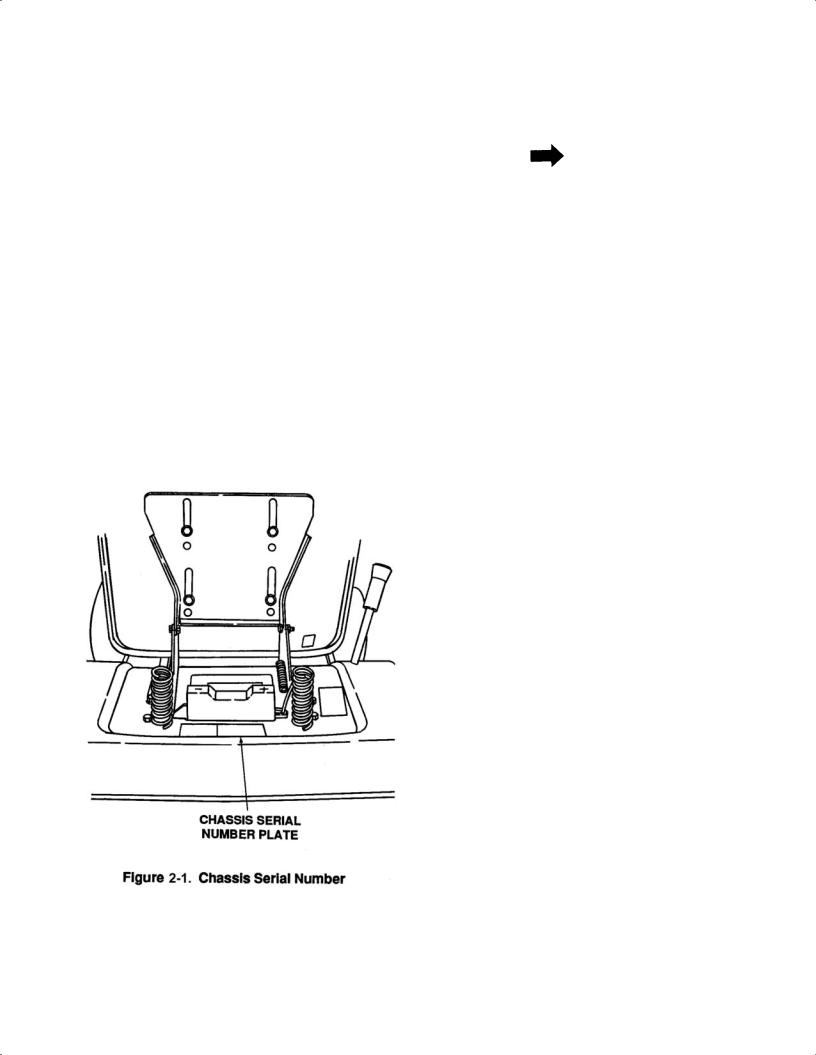
MANUALEQUIPOSPESADOS.COM
GENERAL INFORMATION AND SAFETY PRECAUTIONS
2-1. SAFETY PRECAUTIONS.
2-1.1 Refer to the Safety Summary on page 1-1, and observe all WARNINGS and CAUTIONS when servicing equipment covered in this manual.
2-2. GENERAL.
2-2.1 This service manual covers lawn mowers, riding equipment, snowthrowers, chore performers, rotary tillers and accessories through model year 1998.
2-2.2 More detailed instructions can be found in each of the individual model service manuals.
2-3. REFERENCE DATA.
2-3.1 Serial Number Location. Serial number plate is located behind the seat on the rear fender. See Figure 2-1.
NOTE |
2 |
|
|
LEFT and RIGHT indicate the left and right side when facing forward in the driver’s seat or behind the piece of equipment.
2-4. NUMBERING SYSTEM.
2-4.1 Due to the many different models, types of equipment and parts, it is very important to understand the MTD numbering system and how it is used. The following pages, Figures and Tables will explain the system and what each number and digit means.
 NOTE
NOTE
IMPORTANT: When ordering replacement parts, it is necessary to use both the model number and the date code.
2-4.2 Due to the many different colors of rims and different tire tread designs on riding mowers, orders for replacement tires and wheel assemblies must specify both color and tire brand. These can be identified by using the appropriate 900 series number after the part number.
 NOTE
NOTE
If you are entering an order electronically, the tire identification number can be entered where the paint code number is entered for a painted part.
2-5. CUSTOMER NUMBERS.
2-5.1 In addition to customers who purchase tractors and equipment marked with the MTD brand and name logos, there are customers who order tractors and equipment marked with their own brand name and/or logos. Basic units are the same except for color and decoration.
2-6. GENERAL.
2-6.1 The main storage or electrical power in our electric start lawn mowers, riders and tractors is the battery. With proper setup and mainte-
2-1
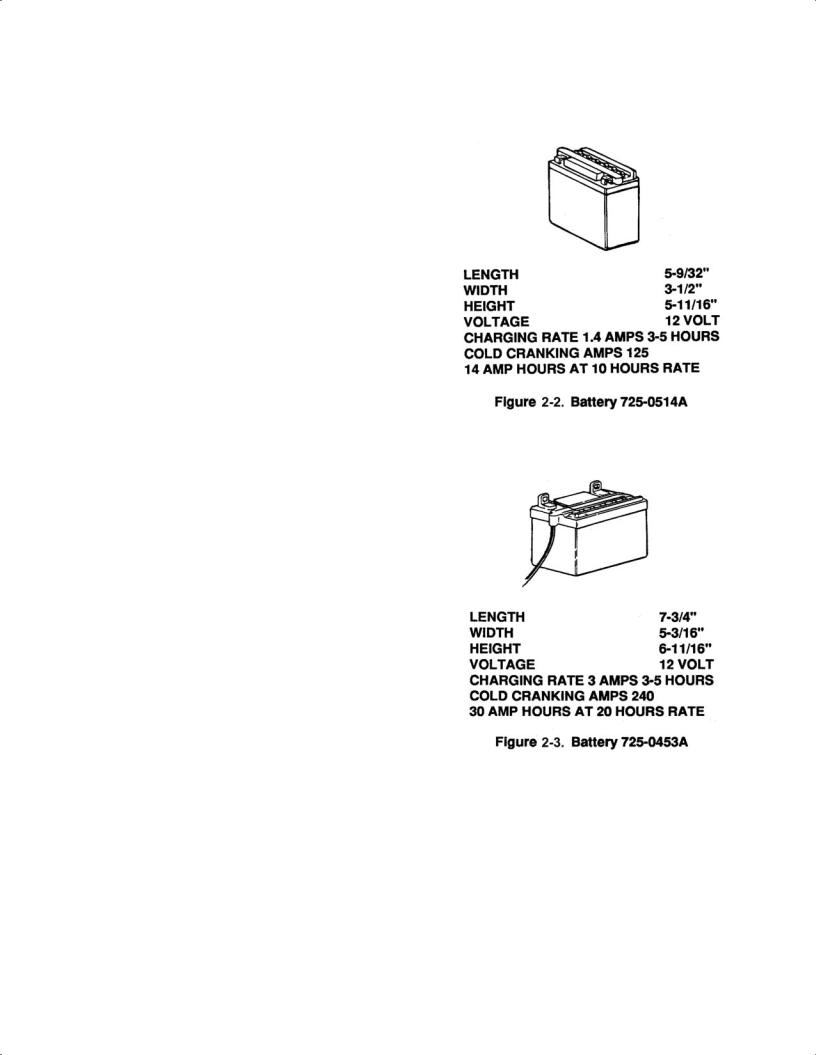
MANUALEQUIPOSPESADOS.COM
BATTERIES AND CHARGING SYSTEMS
nance the battery will last for years. However, in some remote cases even with proper maintenance a battery can lose power. This is unavoidable and should be handled as per warranty guidelines.
2-6.2 A chemical reaction between the battery’s electrolyte and plates, or electrodes, will supply electrical energy to an external circuit. When the battery is being used, or discharging, the positive plate (lead dioxide) and the negative plate (sponge lead) are both changed to lead sulphate. At the same time, part of the electrolyte (diluted sulfuric acid) is changed to water. This conversion of diluted sulfuric acid to water reduces the specific gravity of the electrolyte. By measuring this specific gravity, a direct measure of how far the discharge process has progressed can be made.
2-7. BATTERIES AND CHARGING RATES.
2-7.1 There are basically 5 different batteries used. In this section we will show the battery number, the replacement number, cause of replacement, size, cold cranking amps and amp hours at a given rate.
1.Battery 725-0514A (Figure 2-2) is replaced by 725-1633. These batteries are used on riders and are the same size with the same cold cranking amps. The number was changed due to shipping regulations which would not allow acid packs to be shipped with batteries. Acid packs can be obtained by ordering part number 725-1637; however, we suggest dealer obtain acid locally. Battery caps, part number 725-0691, can also be ordered separately.
2.Battery 725-0453A (Figure 2-3) is shipped with no acid. Acid can be obtained by ordering part number 725-1637, but it is suggested acid be purchased locally. Battery caps can also be purchased separately by ordering part number 725-0690. Battery 725-0453A was used on 1989 and prior 700 and 800 series tractors. This battery is currently used in the 900 series tractor.
3.Battery 725-1105 which was supplied in 1987 is no longer available. Use kit number 7530459 as a replacement. The kit includes a battery, cover and adapting clip. The larger terminal end goes on the negative side of the battery. The adapting clip also goes on the negative side. The electric start unit uses a 7 amp fuse system
4.Battery pack 725-1276 (Figure 2-4) is installed in electric lawn mowers.
2-2
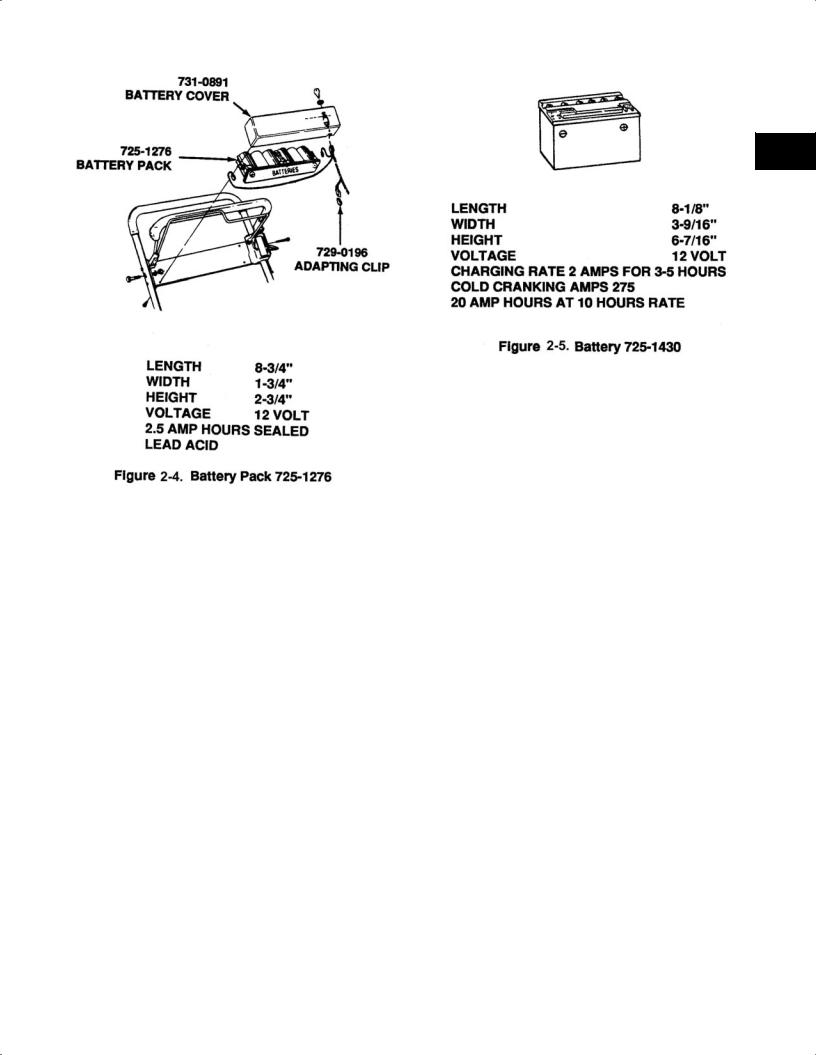
MANUALEQUIPOSPESADOS.COM
2
 NOTE
NOTE
During shipment, the hot wire can vibrate off the battery and the unit will not start. Take the battery cover off, hook up the wire and charge the battery.
5.Battery 725-1430 (Figure 2-5) is replaced by 725-1635. These batteries are the same size with the same cold cranking amp. The number was changed due to shipping regulations which do not allow acid packs to be shipped with batteries. Acid packs can be obtained by ordering part number 725-1637; however, we suggest dealers obtain acid locally.
 NOTE
NOTE
Batteries 725-1430 only contain a special chemical sulfate stop that has been added to reduce sulfate crystal deposits (which eventually prevent the battery from accepting a charge). Sulfate stop is a white powder chemical that may be visible before the battery is activated, but dissolved once electrolyte is added. After charging the battery (with sulfate stop added), the specific gravity of electrolyte rises to 1.280 or above. On a 5 ball hydrometer, it is acceptable to see the fifth ball float. If the battery contains sulfate stop and has not been in use for a long period of time, extended recharging time is required.
2-3

MANUALEQUIPOSPESADOS.COM
2-7.2 BATTERIES SECTION 1996-1998
#725-0453 E Battery Type U1-11L
Dry 380 CCA Cold Cranking Amps @ Zero Degrees Group No. U1L
Voltage 12V
Size Top 5.18 x 7.7 Number of plates 66
Height 6.12 to top of post 7.16 Weight wet 20.6 lbs. Electrolyte capacity 72 oz.
Previously this battery was 240 CCA and it has been upgraded to 380 CCA which gives added cranking power in cold weather. It is shipped dry and it is suggested that the acid should be purchased locally. The acid pack number as shown is #725-1670 but acid is considered to be hazardous material, therefore when shipped, charges will be excessive due to special handling.
Battery #725-1704
Note! New Warning symbols
Battery Type U-1
Wet 125 CCA Cold Cranking Amps
All batteries are date coded
Replaced by #725-1707 C DRY 275 CCA Cold
Cranking Amps
Size 5.18 x 7.7
Height 6.12 with Post 7.29
Voltage 12 volts
The #725-1704 is a wet battery meaning that it is shipped in the rider and it is hooked up with the positive terminal connected and the negative terminal has a plastic cover over it to protect from shorting out. The purpose of this is to assist stores with fast product turnover and in this manner the unit is ready to operate in the least amount of set-up time.
Battery #725-1705C
WET 150 CCA Cold Cranking Amps. Battery Type U-1
All batteries are date coded
Replaced by #725-1707C DRY 275 CCA Cold Cranking Amps.
Voltage 12V
The #725-1705C is a wet battery and it is the same as stated above. If a failure occurs in warranty the #725-
1707C will be shipped.
Battery #725-1706
WET 270 CCA Cold Cranking Amps. Battery Type U-1
Negative terminal covered with a plastic cover and shipped with the positive cable connected. Replaced by #725-1707C DRY 275 CCA Cold Cranking Amp.
All batteries are date coded Battery is non-serviceable Voltage 12V
The #725-1706 is a wet battery and is shipped in the tractor and is ready to go by just removing the plastic cover on the negative terminal and connecting the negative cable to the negative terminal.
Battery #725-1707C
DRY 275 CCA Cold Cranking Amps.
Battery Type U-1 Flat Top
Size 5.19 x 7.72
Height 6.12 Including Post 7.30
Voltage 12V
Manifold Vented
Specifications for ’97-’98 will be the same except all will be flat top style. The knobs will be flush with the top of the battery.
YUASA - EXIDE makes the DRY, add acid type batteries EAST PENN makes the WET non-serviceable type battery.
WET batteries are anticipated to be used in 50% of our production for fast moving product customers, all batteries can not be shipped wet because they would have a shorter shelf life than a dry battery.
For ’97-’98 little changes are anticipated. Dependability over all styles will remain the same. Replacement batteries will continue to be shipped without acid, and acid must be obtained locally due to acid being a hazardous material, therefore requires special handling when shipped.
New for ’98 season batteries will be similar in size but top will be flat with nothing sticking up except the posts. Fill caps will be flush with the top of the battery.
2-4
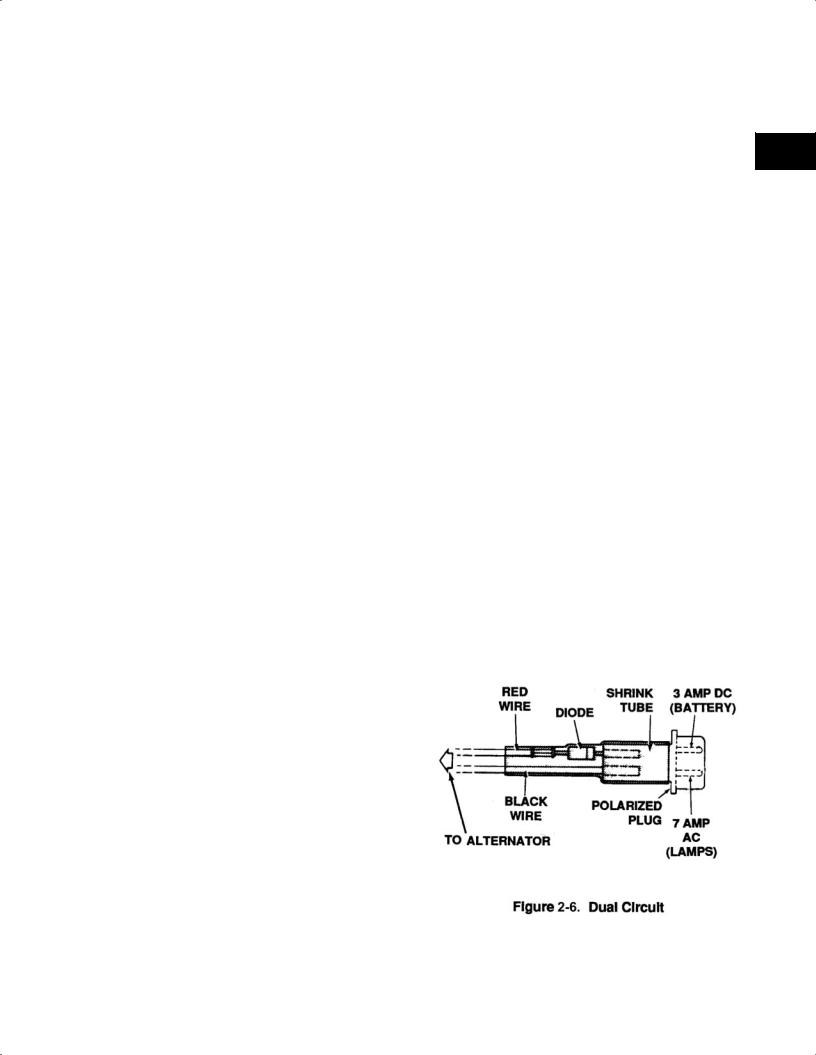
MANUALEQUIPOSPESADOS.COM
Batteries must be properly maintained if you want long-life, this remark is repeated over and over.
1.Check the electrolyte and add only water.
2.Keep clean, excessive acid build up around the terminals and top of battery will cause a discharge and drain the battery.
3.Check cables and clamps and battery case for obvious reasons of leakage as this could cause damage to the painted surfaces, the battery compartments and to the pulleys and transmission.
4.Make sure of the routing of the vent tubes and that it is not pinched and left to drip on pulleys, etc.
5.Replace caps firmly, if one or two gets lost, replace them as soon as possible, often they can be obtained from old batteries.
6.Maintain a fully charged battery with a reading by hydrometer showing 1.265.
2-7.3 Recently, a man well experienced in automobiles and lawn and garden equipment was charging a battery in his automobile in the garage for a long period of time and decided to check on how it was progressing. He walked into a partially dark garage, not thinking, and leaned over the battery and flipped on this cigarette lighter. Well, you can guess what happened next. The electrolyte gas exploded, which is hydrogen and oxygen. He was very lucky to have glasses on as the top of the battery hit him in the face. He quickly remembered to turn the hose on his face and wash off the acid which was starting to burn and no damage was done, but he was left quite shaken and thankful that things worse didn’t take place.
Think about it. His glasses were broken and bent tight to his eyes which helped protect his eyes, which proves it is a good practice to wear glasses when working with batteries.
2-8. BATTERY STARTING CIRCUITS.
2-8.1 Battery starting circuits consists of the following: •Battery as a source of energy
•Starter solenoid switch to transfer high starting current from battery to starter (starter relay) •Key start switch or other switch to energize the starter solenoid
•Starter. A series wound, low resistance, high current draw direct current motor.
 NOTE
NOTE
Sometimes the circuit breaker kicks out and will not allow the unit to crank. Check the diode wires to see if they are crossed. Reverse the diode wires if crossed.
2
2-9. BATTERY CHARGING SYSTEM.
2-9.1 There are four types of charging systems typically used on lawn and garden equipment. •Single circuit—3 amp system with one diode •Dual circuit—3 amp AC system that runs the lights and a 3 amp DC circuit to charge battery •Tri-circuit—5 amp two diode system •Regulated 16 amp system
MTD mainly uses the dual circuit and regulated systems.
2-9.2 Regulated systems are installed on units with electric clutches. These are Briggs and Stratton engines with a voltage regulator. Some of the early units had an 8 amp circuit breaker in the unit. This is a 16 amp unit and needs a 20 amp circuit breaker (part number 725-1382).
2-9.3 Dual Circuit (Engine Alternator) (Figure 2-6).
1.The charging system is an alternator located under the flywheel. A half wave rectification (single diode) is unregulated and rated at 3 amps at 3600 RPM.
2-5
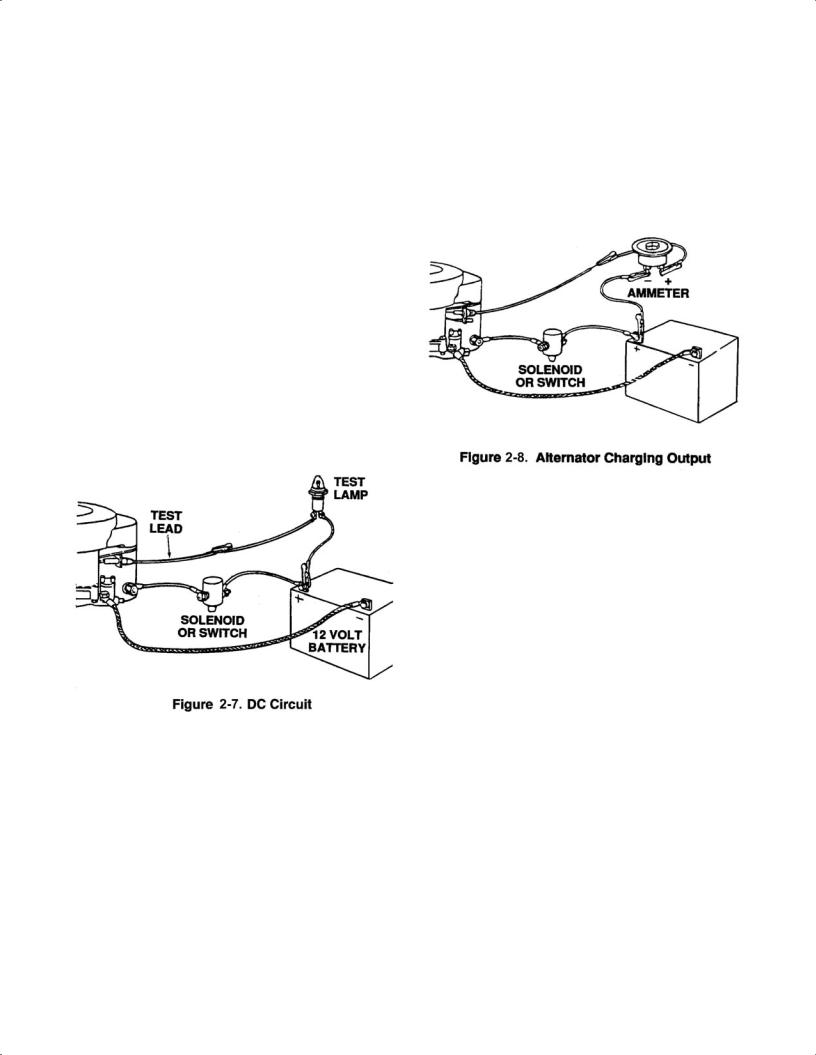
MANUALEQUIPOSPESADOS.COM
2.The diode changes AC to DC to charge the battery. A bad diode can either fail to charge the battery or discharge the battery if the alternator is shorted as well as the diode.
3.The 7 amp AC terminal operates the head lamps. The voltage rises from 8 volts at 2400 RPM to 12 volts at 3600 RPM. Therefore, the brightness of the lights changes with engine speed. In certain situations it is necessary to make use of the entire AC signal. To accomplish this we use multiple diodes in a bridge configuration. This produces full wave rectification (regulator) which is regulated and rated 16 amps at 3600 RPM.
4.The 16 amp DC terminal at 3600 RPM operates the head lamp. The regulated system produces 12 volts DC which goes to the battery.
Engine speed will determine amount of amps regulated.
2-9.4 Testing the DC Circuit (Figure 2-7).
1.Disconnect the charger lead from the battery (small red wire).
2.Connect a 12 volt test lamp between the DC charge lead and the positive terminal of the battery.
3.With the engine off, the lamp should not light. If it does, the diode and possibly the alternator may have failed.
4.Start the engine. The lamp should light. If it does not, the alternator (starter) or lead wire could be bad.
2-9.5. Battery Runs Down.
2-9.5.1 Testing Alternator Charging Output.
Install ammeter in series with charging lead. See Figure 2-8. Start engine. Ammeter should indicate charge. The charge rate is dependent upon the condition of the battery. If ammeter shows no charge, test stator and regulator.
2-10. BATTERY SHIPPING AND STORAGE.
2-10.1 Check List For Proper Battery Storage.
1.Electrolyte level correct.
2.Battery fully charged.
3.The exterior of the battery is clean.
4.Store battery in a cool place.
5.Rotate stock. Always use the oldest battery first.
2.10.2Dry Charged Battery Storage.
1.A dry charged battery has a shelf life of about five years.
2.Keep in a cool, dry place with the humidity as low as possible with a temperature between 60°F and 90°F. The temperature should be uniform and not subject to frequent changes.
3.Once a dry charged battery is actuated, it must be maintained the same as any wet battery.
2-6
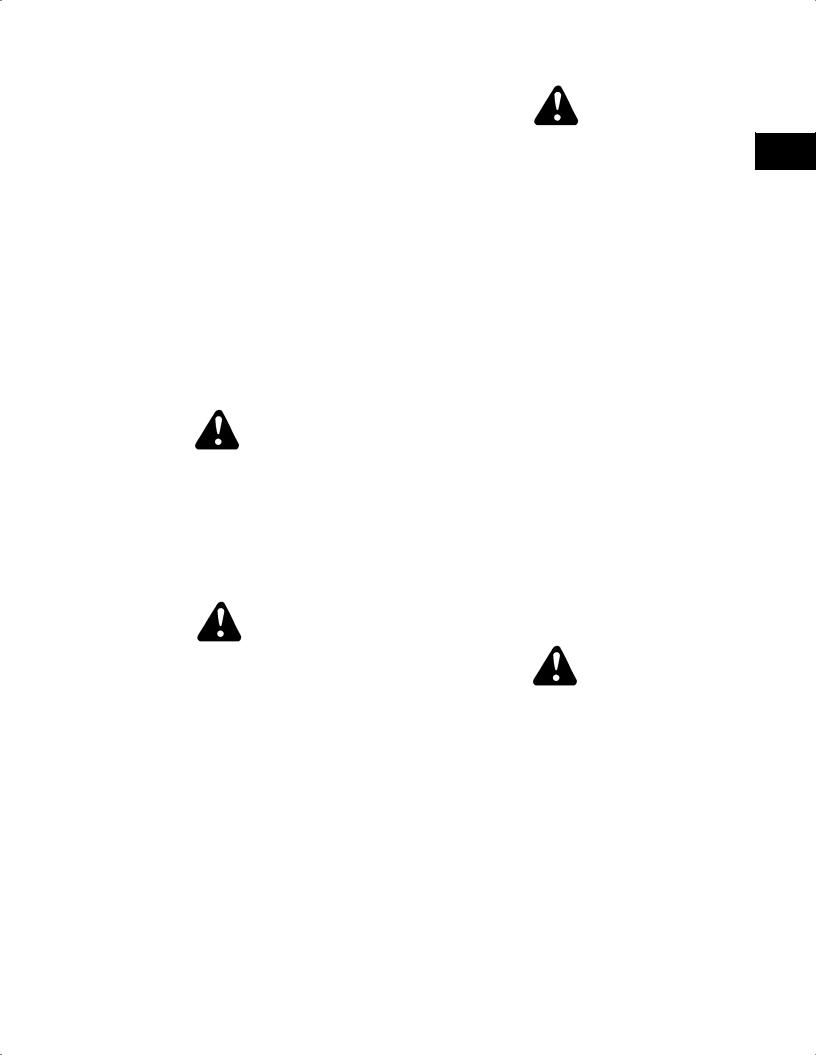
MANUALEQUIPOSPESADOS.COM
2-10.3 Wet Battery Storage.
1.Wet batteries will slowly discharge while in storage.
2.Batteries not used in the winter should be stored in a fully charged condition.
3.Batteries in storage discharge slower when kept cold than when too warm.
4.The best place to store the battery is in the equipment.
2-11. ACTIVATING BATTERY.
2-11.1 The instructions listed below are packed with every battery shipped with each unit. Following these steps will prevent premature battery failure.
WARNING
LAWN AND GARDEN EQUIPMENT BATTERY (DRY AND CHARGED) FILLING AND INSTALLATION INSTRUCTIONS. Do not fill with electrolyte until battery is actually placed in service. This battery is supplied dry and charged. Do not fill with electrolyte until battery is to be used.
WARNING
POISON—CAUSES SEVERE BURNS. Contains sulfuric acid. Avoid contact with skin, eyes or clothing. To prevent accidents, neutralize excess acid with baking soda and rinse empty container with water. KEEP OUT OF THE REACH OF CHILDREN.
ANTIDOTE: EXTERNAL—Flush with water.
INTERNAL—Drink large quantities of water or milk. Follow with milk of magnesia, beaten eggs or vegetable oil. Call physician immediately
EYES—Flush with water for 15 minutes and get prompt medical attention.
WARNING
DANGER—BATTERY CONTAINS SULFU- 2 RIC ACID MAY CONTAIN EXPLOSIVE GASES.
•Keep sparks, flame, cigarettes or any flame away.
•Shield eyes, protect skin and clothing when handling acid or battery containing acid or working near such batteries.
•Ventilate when charging or using battery in enclosed space.
•Make sure venting path of battery is always open once battery is filled with acid.
 NOTE
NOTE
When the battery is charged, the heat will expand the electrolyte.
1.Allow the battery to sit 20 to 30 minutes. This allows the chemical action to take place.
2.The battery must be charged at the maximum rate until a specific gravity is reached. See paragraph 2-1.4.
3.Add electrolyte until it reaches the split ring.
CAUTION
DO NOT ADD ACID. Add only distilled water.
4.After charging, replace vent plugs firmly, wash off acid spillage with water and dry the battery.
5.If time does not permit charging the battery, or if charging equipment is not available, the battery should be installed and the unit should be run continuously for 20 to 30 minutes in order to sufficiently charge the battery.
2-11.2 Preparation for filling the battery is very important.
1.Remove vent plugs just before filling with electrolyte.
2-7
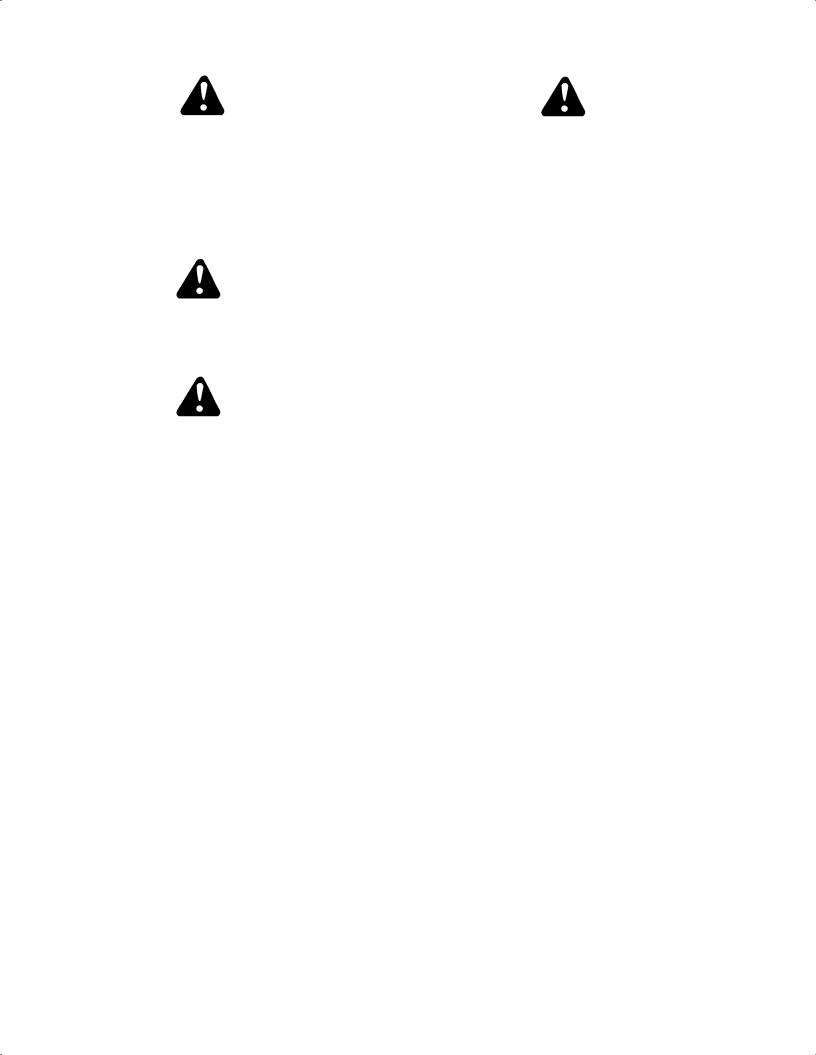
MANUALEQUIPOSPESADOS.COM
WARNING
Internal gas pressure can cause battery to explode if sealing tube is left in place.
2.If your battery has a short sealing tube on the vent elbow and is supplied with a separate long tube, pull off short one and replace with long one.
WARNING
Electrolyte is sulfuric acid solution. Avoid spillage and contact with skin, eyes and clothing. See WARNING on back panel of battery.
CAUTION
Do not use water or any other liquid to activate. During cold weather, if electrolyte (acid) is stored in cold area, warm electrolyte to room temperature before filling.
3.Fill battery with electrolyte (diluted sulfuric acid) of a specific gravity of 1.265. Fill to upper level as indicated on battery. Electrolyte should be at room temperature before filling.
2-12. BATTERY INSTALLATION INSTRUCTIONS.
1.Remove old battery. Mark which cable is connect ed to positive (+) and negative (-) terminals. Positive cable is usually red.
2.Clean cable connectors with wire brush or sand paper to remove oxidation.
3.After filling with acid and charging (see instructions), install new battery. Connect cables to the proper terminals. Positive cable to positive terminal (+) and negative cable to negative terminal (-). CONNECT NEGATIVE CABLE LAST.
CAUTION
Connecting in reverse, positive to negative and negative to positive, can cause serious damage to electrical system.
4.Check vent tube to avoid any crimping or obstruction to the tube.
5.Securely fasten battery to the unit using its battery hold-down arrangement. This will minimize destructive vibration.
2-13. COMMON CAUSES FOR BATTERY FAILURE.
2-13.1 Overcharging. Charging a battery greatly in excess of what is required is harmful in several ways, as follows:
1.Severely corrodes the positive plate grids with consequent mechanical weakening and loss of electrical conduction.
2.Decomposes water of electrolyte into hydrogen and oxygen gas. Gas bubbles tend to wash active material from the plates and carry moisture and acid from the cells as a fine mist.
3.Decomposition of water leaves acid more concentrated. Concentrated acid is harmful to cell components, particularly at high temperatures over a prolonged period of time.
4.High internal heat is created, which accelerates the above mentioned corrosion of positive plate grids and damages separators and negatives. Also, containers may be softened and distorted.
5.Overcharging alone or in combination with a previous condition of undercharging may cause severe buckling and warping of positive plates with accompanying perforation of separators.
6.May cause damage by corrosion to battery box, cables and other vital electrical and engine parts by forcing liquid from the cells if charge rates are excessive.
2-8

MANUALEQUIPOSPESADOS.COM
2-13.2 |
Undercharging. |
plates are exposed, the acid will reach a dan- |
|
|
|
gerously high concentration that may char and |
|
1. |
A battery operated with insufficient charge over |
disintegrate the separators and may perma- |
|
|
a long period of time may develop a type of |
nently sulfate and impair the performance of |
|
|
2 |
||
|
sulfate in the plates which is dense, hard and |
the plates. Plates can not take full part in the |
|
|
coarsely crystalline and which cannot be |
battery action unless they are completely cov- |
|
|
|
||
|
readily electrochemically converted to normal |
ered by the electrolyte. Sulfuric acid must |
|
|
active material again. Such lead sulfate, being |
never be added to a cell unless it is known that |
|
|
less dense than the active material from which |
acid has been spilled out or otherwise loose |
|
|
it was formed, will set up strains in the positive |
from the cell. |
|
|
plates so that distortion or bowing of the plates, |
|
|
|
called buckling, may result. Buckling will be |
2-13.4 Loose Holddowns. Holddowns, if not properly |
|
|
produced, especially if the sulfated battery is |
adjusted, may allow the battery to bounce |
|
|
subjected to sudden prolonged overcharging, |
around in the battery box. This may cause the |
|
|
as might be experienced by an alternator or |
bridges on which the elements rest to notch |
|
|
generator-regulator system which has gotten |
the bottom of the separators and may cause |
|
|
out of adjustment. Severely buckled plates will |
the plates to notch the bridge tops causing a |
|
|
pinch the separators at the plate corners or |
severe disarrangement of the elements. The |
|
|
chafe the center of the separators. This may |
bouncing of the battery may also crack or wear |
|
|
result in perforations of the separators and |
the container badly and cause acid to leak. |
|
|
develop a short circuit in the cell. |
Leaking acid corrodes terminals and cables |
|
|
|
and results in high resistance battery connec- |
|
2. |
A battery operated in an undercharged condi- |
tions, thereby weakening the battery’s power |
|
|
tion is not only unable to deliver full power, but |
and shortening its life. If holddowns are too |
|
|
is liable to freeze during severe winter weather. |
tight, they can distort or crack the container, |
|
|
See par graph 2-8.7. |
allowing loss of acid from the cells. This will |
|
|
|
cause loss of battery capacity. |
|
3.Lead sulfate formed on the plates during dis-
charge is relatively insoluble as long as the 2-13.5 Battery Electrolyte Substitutes. No satisfac-
specific gravity of the electrolyte indicates a substantially charged condition. If allowed to drop much below this state the lead sulfate becomes increasingly soluble and, aided by temperature fluctuations of the electrolyte, may migrate over a considerable period of time into the pores of the separators and deposit as a white crystalline mass. Subsequent charging may convert these crystalline deposits to metallic lead which may short the positive and negative plates through the areas of the separators affected. These small shorts may cause a condition of low cell voltage when the battery is charged. For this reason battery cells should not be allowed to stand idle in a discharged condition.
2-13.3 Lack of Water. Water is one of the essential chemicals of a lead-acid storage battery and under normal conditions of operation is the only component of the battery which is lost as a result of charging. It should be replaced as soon as the liquid level falls to the top of the separators. If water is not replaced, and the
tory substitute electrolyte has been found for the simple mixture of sulfuric acid in water. Use no substitutes.
2-13.6 Excessive Loads. A battery should never be used to propel the rider by the use of the starting motor with clutch engaged except in a great emergency. This may produce extremely high internal battery temperature and damage the starting motor.
2-13.7 Freezing of Electrolyte.
1.The electrolyte of a battery in various states of charge will start to freeze at temperatures indicated below. The given temperatures indicate the approximate points at which the first ice crystals begin to appear in the solution. The solution does not freeze solid until a lower temperature is reached. Solid freezing of the electrolyte may crack the container and damage the positive plates.
2-9
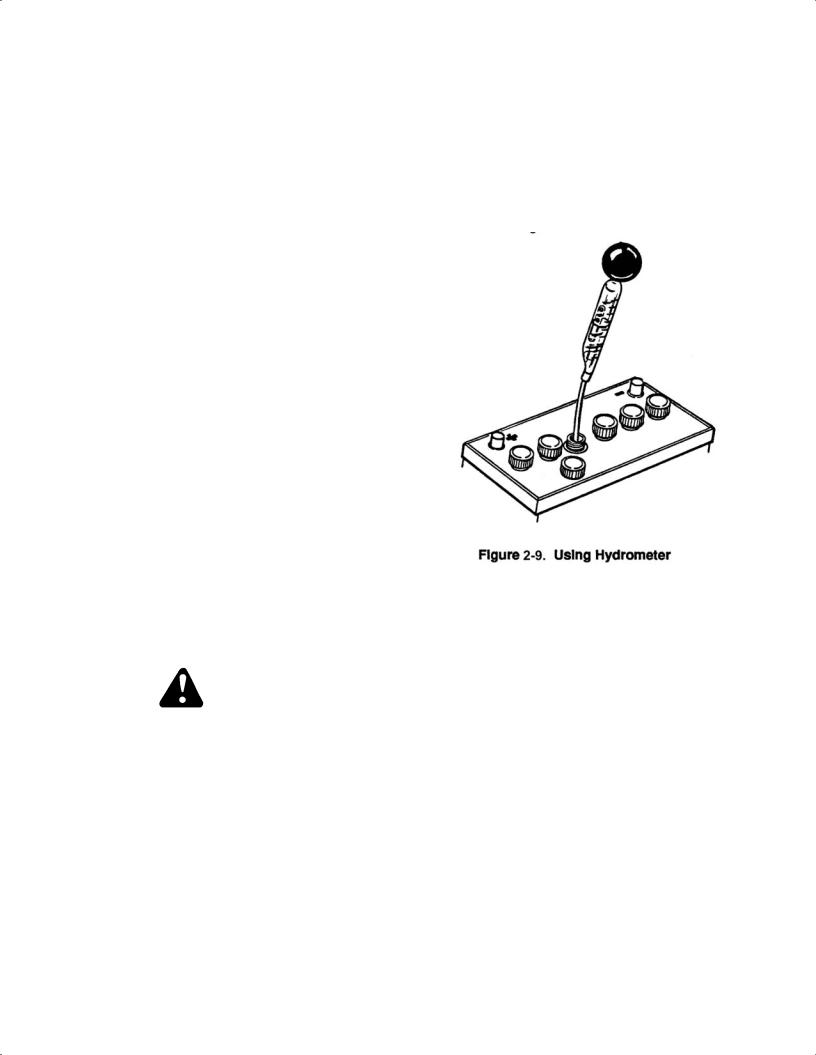
MANUALEQUIPOSPESADOS.COM
2.A 3/4 charged automotive battery is in no danger from freezing. Keep batteries at 3/4 charge or more, especially during winter weather.
3.Battery power decreases while the need for engine power increases with falling temperatures.
80°F
32°F
0°F
4.Sub-zero temperatures reduce the capacity of a fully charged battery to 30% of its normal power and at the same time increases cranking load beyond the normal warm weather load.
 NOTE
NOTE
The above failures do not constitute a warranty.
2-14. TESTING THE BATTERY.
2-14.1 A visual inspection of battery should be done by checking for:
1.Broken or leaking cover.
2.Broken case.
3.Damaged post.
4.Other.
2-14.2 Batteries should be handled with care. Never leave battery standing in a discharged position.
WARNING
Never test a battery by striking a cable across the output terminals. An internally shorted battery could EXPLODE.
2-14.3 The hydrometer measures the state of charge. Use of the hydrometer will also pinpoint a shorted cell which, in some instances, cannot be charged or will not hold a charge. See Figure 2-9.
1.Specific gravity tests must be performed before adding water to the battery.
2.In the event the electrolyte level is too low to test with the hydrometer, add water and charge before testing.
3.A correct specific gravity reading can be measured only when the electrolyte temperature is 80°F. If the electrolyte temperature varies from this temperature, compensation must be made in the reading as follows:
a.Add four gravity points (.004) for each 10° electrolyte temperature is above 80°F.
b.Subtract .004 for each 10° below 80°F.
4.In taking the hydrometer reading, the float must be floating freely and the eye must be even with the liquid level to obtain accurate readings.
5.When all cells are tested, if the specific gravity between the highest and lowest cell varies 50 points (.050) or more, condemn the battery; it is no longer serviceable.
6.If there is less than a 50 point variation between the highest and lowest cell, and the specific gravity in one or more cells is below 1.235, recharge the battery.
7.The inability to bring the specific gravity of any one cell up to 1.235 after charging is also an indication of an unserviceable battery and it should be condemned.
8.After the recharge, let the battery stand at least 24 hours, and repeat hydrometer test on all cells. If there is a variation of 50 points or more between the highest and lowest cell, condemn the battery.
2-10
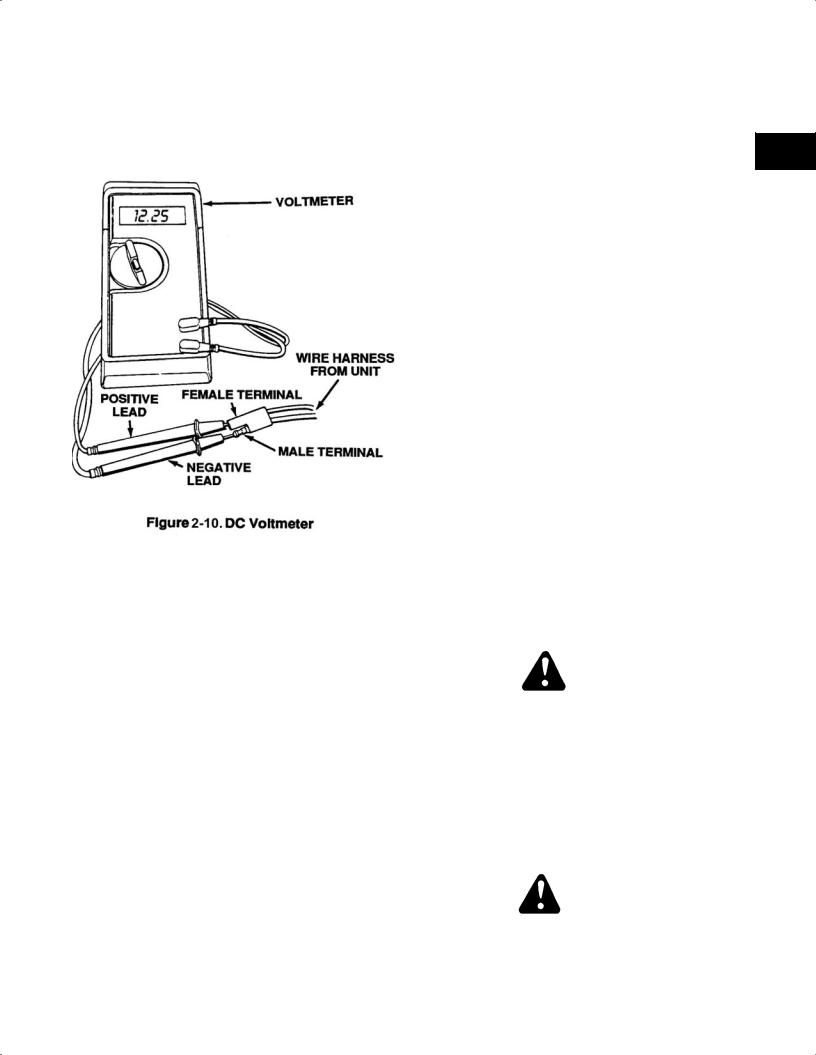
MANUALEQUIPOSPESADOS.COM
2-14.4 Batteries 725-1105 and 725-1276 are 12 volt sealed lead-acid batteries. These batteries can be checked by using a standard DC voltmeter. When checking the voltage, the male terminal of the connector plug of the harness is the negative terminal. See Figure 2-10.
2-14.5 Check battery charge with voltmeter as follows:
 NOTE
NOTE
Check to be certain the in-line fuse in the wire harness is OD.
1.Connect the negative lead of the voltmeter into the male end of the plug on the wire harness.
2.Connect the positive lead of the voltmeter into the female pin on the plug on the wire harness.
3.A fully charged battery will register 13.0 volts on the voltmeter.
4.A battery that needs charging should read between 11.0 and 13.0 volts.
5.If the reading is below 10.0 volts on the voltmeter, the battery probably will not accept a charge and should be replaced.
2-15. BATTERY CHARGERS AND CHARGING.
2-15.1 Restore charge.
1.An electric current is sent through the cell in the reverse direction to that in which the current flows when the battery is delivering current. The charging rate must be slightly higher
than the voltage. A single battery cell produces |
2 |
|
|
approximately 2 volts. A 12 volt battery will |
|
consist of six 2 volt cells. To charge a 12 volt |
|
battery requires (.5 volts x 6 cells = 3 volts) (12 |
|
volts + 3 volts = 15 volts). When a battery is |
|
discharged, its internal resistance is low. In this |
|
low resistance condition, the battery will draw a |
|
greater charging current. As the battery |
|
becomes charged, the internal resistance |
|
increases and the current draw will diminish. |
|
2.Batteries should only be tested with a hydrometer for specific gravity, or a test device that applies a current draw to the battery while testing. A voltmeter does not give an accurate indication of battery condition, as even a partially discharged battery will indicate correct voltage when not under load. The normal specific gravity of a charged battery should be between 1.285 and 1.300 approximately. A discharged battery cell has a specific gravity of 1.150 approximately.
2-15.2 Recharging is necessary when you find lights get dim, and/or when battery is not used for longer than one month. Charge the 12 volt battery with a 12 volt 1 amp automotive charger. Recommended charging for 6 volt or a 12 volt battery should not exceed 1 amp. Charge until battery gases freely and specific gravity of electrolyte rises to 1.265 or above.
WARNING
When charging, care must be taken to ventilate the fumes from the battery as they are highly EXPLOSIVE. The gases issuing from a charging battery are a mixture of hydrogen and oxygen gases and will explode with great violence and spraying of acid if a spark or flame is brought too near them. A room or compartment in which charging batteries are confined should be ventilated. Do not bring flame or sparks near vent openings.
WARNING
In all automotive battery cells small quantities of hydrogen gas are given off at the negative plates when the cells are not being charged. It
2-11
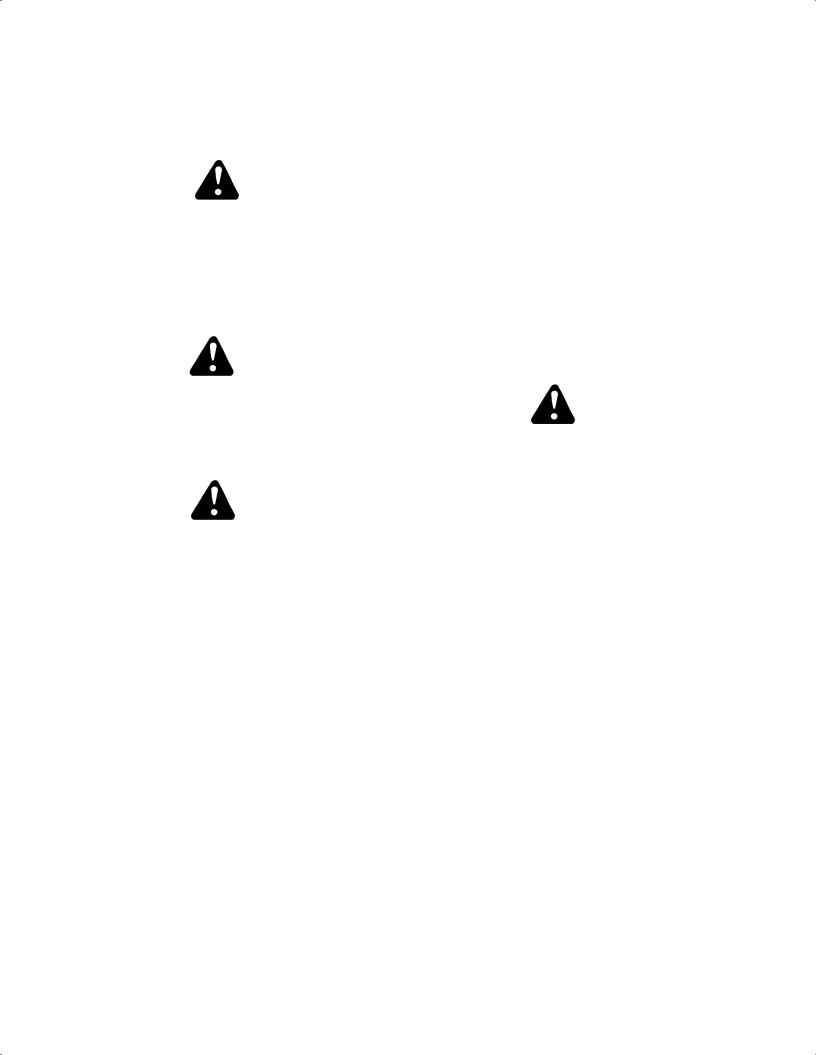
MANUALEQUIPOSPESADOS.COM
must therefore be assumed that explosive mixtures of hydrogen gas are present within the cells at all times. A torch, match flame, lighted cigarette or sparks from metal tools accidentally contacting the terminals could cause ignition of the gases.
WARNING
To avoid sparks, do not disturb connections between batteries while charging: first throw switch “off” at the charger. The possibility of ignition of hydrogen gas by static electricity when working on or near batteries is minimized by grounding ones self and the vehicle to remove any static charge.
WARNING
The improper use of a booster battery to start a rider, when the normal battery is inadequate, presents a definite explosion hazard. To minimize this hazard the following procedures are suggested.
CAUTION
Exceeding the recommended charging rate can cause warping of the plates and will affect the life of the battery.
1.When possible, use equipment with a switch in the line connecting the booster battery to the installed battery. Check to see that both batteries have the same voltage type: e.g., 6 volt or 12 volt.
2.If only jumper cables are available and the booster battery is in a car, set the hand brakes, turn off accessory switches and ignition keys and place the gearshift or gear selector in the neutral or park position for both vehicles. Now proceed in exact sequence.
3.Always rock the connector clips to insure secure grip contact.
a.Connect one end of first cable to the terminal of the discharged battery which is connected to the starter switch or solenoid (not grounded). Note if this is the positive or negative battery terminal.
b.Connect the other end of the first cable to the terminal post of the booster battery having the same marking; that is, positive to positive or
negative to negative. Most have a negative grounded electrical system.
c.Connect the first end of the second jumper cable to the other terminal of the booster battery. With the other end make final connection and this is to be the rider frame of the mower with the discharged battery as far away as possible from the battery.
2-15.3 Charging the Battery.
1.Connect the charger to the lawn mower harness.
2.Plug the charger into a 110 volt AC wall outlet.
3.Check the charger after 15 minutes. The charger should be warm to the touch (approximately 100°F).
WARNING
Charger could be HOT and cause burns.
4.If the charger is hot, it is drawing too much current and should be disconnected immediately. One of the following conditions exist:
a.The battery is defective.
b.The polarity of the battery connectors is reversed.
c.There is a short in the wire harness.
5.If the charger is cold to the touch, one of the following conditions exist:
a.The battery is not connected to the wire harness.
b.The charger is bad. Check the output voltage. It should be above 9 volts DC with the male terminal of the charger being positive.
c.There is no voltage present at the wall socket.
d.The charger should be checked once more by touch within an hour. Use caution when touching the charger.
6.Normally, if the unit starts the first time, it is unlikely that the wire harness is defective. However, if the wire harness is suspect after using the above procedures, it should be replaced.
2-12
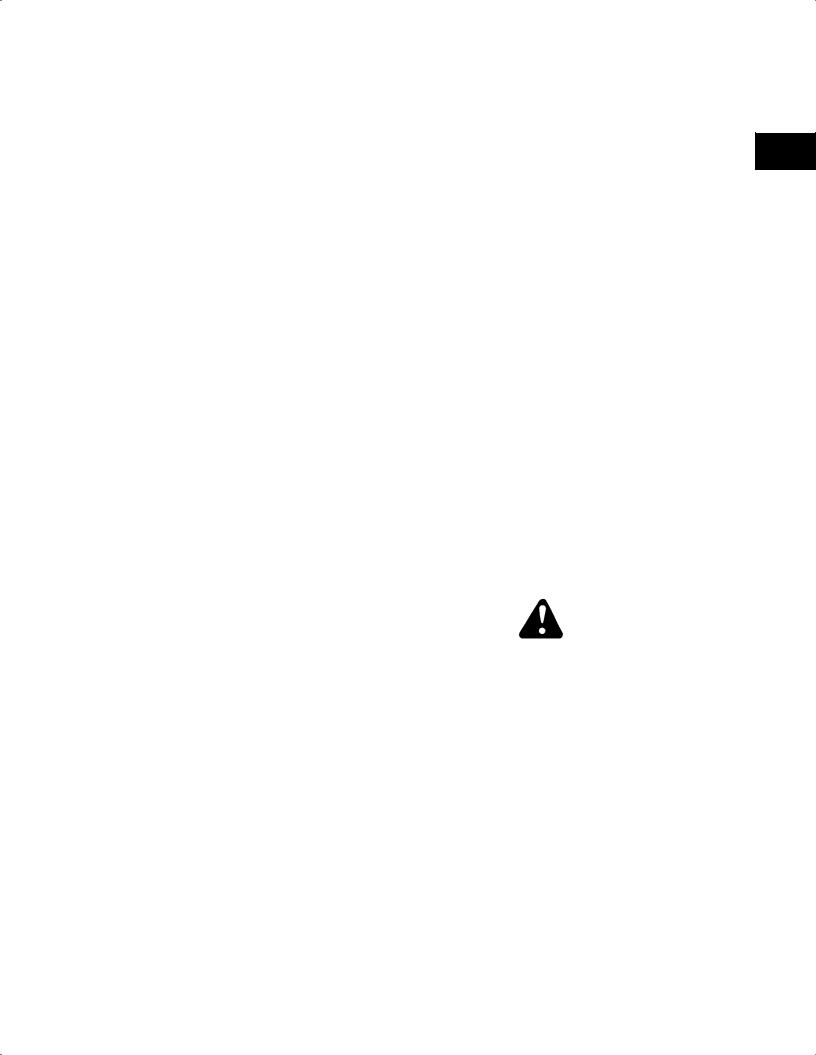
MANUALEQUIPOSPESADOS.COM
2-15.4 Plug-in Trickle Chargers. Different trickle chargers are used for different batteries. The following is a list of chargers and the rate at which the batteries are to be charged.
Plug-In Trickle Chargers
725-0727 300 ma. use on 725-1105 and 725-1276 battery
725-0507 1/2 amp charger, used on 725-0415
725-0579 Alligator clips for 725-0507 charger to be used when charger does not plug into the wire harness
725-0156 Old red Schauer charger. Not available. Use 753-0220. This kit consists of:
1 725-0507 charger
1 725-0579
Charging Rates
725-0130 automotive type with tapered terminals 15 amp maximum
725-0453
725-0661 4-5 amp maximum
725-0117
725-0726 300 ma. elec. start self-propelled 725-1104 lawn mowers
725-1276
725-0514 motorcycle type 3 amp maximum
2-15.5 New Information Concerning Battery Charging. It is important that new batteries are charged according to the owner’s guide or Technical Handbooks Volume I, II and III. We have found that rider and tractor batteries do not have memories, and the capability of recharging a low or dead battery is feasible. A 3 to 10 amp taper charger should be used; charging time varies between 12 to 40 hours. This charging procedure should be followed prior to checking the specific gravity or condemning any rider or tractor battery.
Table 2-1. Specific Gravity Freezing Points
Specific Gravity |
Freezing Point |
1.265 |
-75°F |
1.225 |
-35°F |
1.200 |
-17°F |
1.150 |
5°F |
|
|
1.100 |
18°F |
|
|
1.050 |
27°F |
|
|
2-16 MAINTENANCE AND SERVICE. |
|
||
2 |
|||
|
|
||
2-16.1 Proper maintenance and service could extend the life of a battery. The following procedures should be taken:
1.Clean battery top with a stiff brush, being careful not to scatter corrosion products. Wipe off with a cloth wetted with ammonia or baking soda in water. Fully wipe with a cloth with clean water.
2.Inspect cables—urge replacement if unserviceable. Inspect the terminals posts to see that they are not deformed or broken.
3.Clean the battery and cable contact surface to a bright metal finish whenever they are removed. Coat the contact surfaces with mineral grease or petroleum jelly before the terminals are reconnected.
4.Inspect battery box and adjust holddowns. Urge replacement if unserviceable.
5.Check electrolyte level once a month. If found below middle of UPPER and LOWER LEVEL, add clean drinking water to restore level.
WARNING
NEVER use ACID to refill a battery.
6.Make hydrometer or voltage test.
7.Keep exhaust tube free of kinks and obstructions.
8.Store battery with a full charge. A discharged battery will freeze.
 NOTE
NOTE
All batteries discharge during storage. Recharge battery every two months and before returning to service.
9.Carefully inspect and recharge the battery at the beginning and end of each mowing season.
2-13
